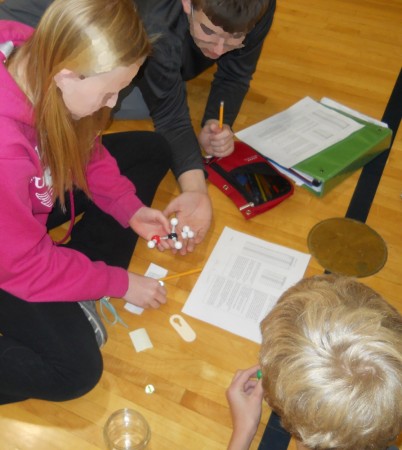
Abstract
This simulation was designed to have middle school students practice reading instructions (proteins) from a sequence of genetic bases (DNA) to better understand how gene translation works and learn the types of things that proteins do. The exercise and discussion lasted 55 minutes (with one preparatory homework assignment). Students appeared to have a lot of fun doing the simulation (especially because of the competition between groups) and we had an excellent discussion afterwards.
Introduction
DNA holds the instructions that control what our bodies in the pattern of molecules (nucleobases) that make up our genes. The genes are located in the nucleus of our cells (as well as for all eukaryotes). When genes are expressed, they create proteins that actually get all the work done.
The jobs of proteins can be summed up a three things:
- some proteins build structures like muscles,
- other proteins are enzymes that catalyze reactions, like the breakdown of food in the digestive system, and
- other proteins are used for sending messages.
Using the DNA Writer application for converting text into simulated DNA sequences, I create an exercise for students to practice:
- Finding simulated genes in a DNA sequence
- translating the genetic code into an instruction (a simulated protein)
- performing the different types of jobs that proteins do.
The simulation was modeled as a competitive game, with the class of 7th and 8th graders broken into four groups that competed against one another to see who could complete the instructions the fastest. I cheated, I’m afraid, because what I did not tell them was that, in order to complete the last instruction, the groups would all need to work together, so there would be no single group winner.
Procedure
Pre-exercise Homework
Example Homework Assignment: HW-eg.pdf
This being the first time I’ve tried anything like this, I was not sure how long it would take students to translate the DNA code to english, so a couple days before the simulation I handed out individualized homework assignments so they could practice. I chose science vocabulary words like “protein”, “ribosome”, and “amino acids” for short, simple messages.
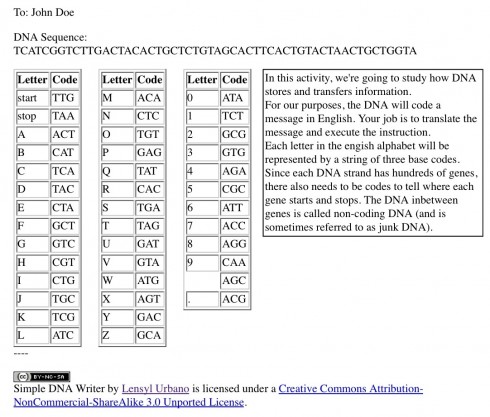
At least I had intended for it to be homework. As soon as they got the handout, and the 2 minute explanation about how it worked, they hashed out the messages in about five minutes.
The trickiest part was that the first few letters they translated did not make any sense, since they’re random sequences meant to represent non-coding DNA. However, once they got to the “start” codon it was pretty easy sailing.
Given how fast they were able to do the translation (and how eager and enthusiastic they were about it), I realized how unfounded were my fears that the translations would take too long for the competitive part of the exercise to work.
The Simulation/Exercise
Materials
There are only a few materials required for this lab:
- envelopes – one for each group (size does not matter)
- a chain of paperclips (100 seemed to work pretty well) You only need one set of 100 because the groups will be working on this together.
- enough parts of a molecule-building kit to make a methane molecule (CH4).
- printout of the translation table (eg. HW-eg.pdf or from DNA Writer).

Preparation
For each group
- Write out the main set of instructions. The instruction I used were:
- PULL APART ALL THE PAPERCLIPS
- BUILD A METHANE MOLECULE
- BUILD A BUTANE MOLECULE
- I used the DNA Writer to get the code for each instruction individually then stuck them together in a text editor (like Word) (Note: it might even be better to give them a bead string with the base sequence instructions). These three instructions together looked like this:
TATTGCACATTGGAGGATATCATCAGCACTGAGACTCACT
AGAGCACTATCATCAGCTAGCGTCTAAGCGAGACTGAGCT
ACACTCAATCCTGGAGTGATAACTCTCACTAGTATAGTCG
TTGCATGATCTGATCTACAGCACTAGCACACTATAGCGTA
CTCTCCTAAGCACATGTATCCTATCAGATATCCTATAATG
TCTATGCGTATCATTGCATGATCTGATCTACAGCACTAGC
CATGATTAGACTCTCCTAAGCACATGTATCCTATCAGATA
TCCTATAAGCAATCCACGCT
- Write or print out an address label as a DNA sequence, and stick it on to the envelope.
- Since my groups had already named themselves, my addresses were something along the lines of, “Give to Gryffendor”.
- Write out a message and stick it into each envelope
- My messages were things like: “Do 10 pushups”; or “Dance Gangnam Style”.
- Chain together the paperclips:
- The groups will be working together to pull apart the paperclips, so you want enough paperclips so that it takes a few minutes to do. This way the slower groups will have a chance to catch up with the faster groups.
- Put the molecule building parts in a jar – one for each group.
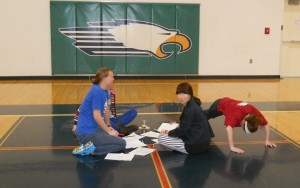
Procedure
So I took the class to the gym and stuck each of the four groups on a side of the basket ball court. Each group had a jar of molecule parts (only enough to build a methane molecule), an addressed letter with a message in it, and the long DNA sequence.
The paperclips were in a box in the center circle of the court.
We gathered around the center circle for instructions, which basically consisted of me telling them they had to
- deliver their message first,
- then do the whatever was in the message delivered to them,
- then follow the instructions in the long DNA sequence
They were eager to go.
Results
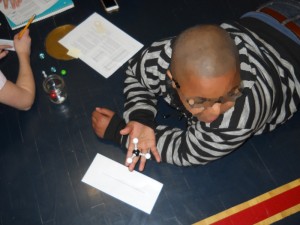
The entire thing went remarkably smoothly, which was somewhat surprising since this is the first time I’ve ever tried anything like this.
It only took 20 minutes from the time they started to when they finally put together the butane molecule.
A few small issues did come up, however.
Since they had only ever decoded a single instruction from a single DNA sequence before, almost all the groups stopped after the first instruction on the long sequence (pull apart the paperclips). I had to point out that a real DNA sequence contains a whole sequence of genes, so they probably ought to continue translating.
Another group tried doing shortcuts, and when they saw that they had parts from the molecule building kit and the instruction was, “BUILD A M”, they assumed that they were just supposed to build any molecule. I had to intervene on that one too.
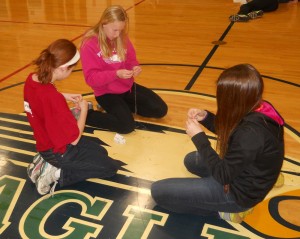
When the person from the third group arrived to help pull apart the paperclips, the two already there complained that more people would just slow them down. I had to point out that they could just break the long chain they were working on into smaller pieces and then everyone could work and the work would go a lot faster. The breaking of the chains is supposed to represent the catalytic effect of enzymes.
One group mistakenly blocked off the first two letters in the DNA sequence instead of the first three (for a codon), and couldn’t figure out why their sequence was not telling them anything. I had to help out with that one, but in our post-simulation discussion it reminded me to talk about transcription errors and how the genetic code can change.
Finally, they were, some more than other, sorely disappointed that there would be no winner. They so wanted to win that they did not want to share their molecule parts to build the butane molecule.

Discussion
When we were done with the exercise, we gathered around in the center circle to debrief. We reviewed what DNA does and the three things that proteins do:
- Assembling the butane molecule from the methane monomers represented the use of proteins to build structures.
- Pulling apart the paperclips represented the breakdown of food in the digestive system. Starches, for example, are long chained polymers that are broken down into their constituent sugars by enzymes in saliva and in the stomach.
- The envelope with the message was a very literal representation of proteins as message carriers.
I actually forgot to talk about the transcription errors one group was making during our circle discussion, so we ended up talking about it on the following day. One student had remembered the video I showed earlier about gene expression that compared the rate of errors in DNA encoding compared to computer disks. The DNA coding is much more reliable, but when billions upon billions of bases are being coded then errors will still creep in.
This lead to a discussion about mutations, and how some DNA transcription errors could give messages that made no sense and would be ignored, while others could send signals that could affect the body’s functions. The latter types of mutation can be good or bad.
Conclusion
The exercise went remarkably well. Key to it, I think, was the fact that the students were able to so efficiently translate the DNA code to English. Also, the instructions were designed to feed back into things they’d done in the past, like assemble covalent molecules and polymers.